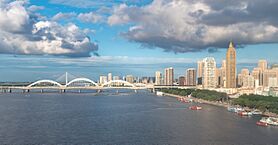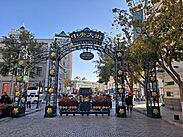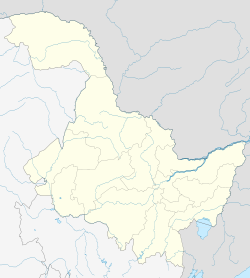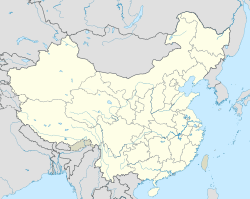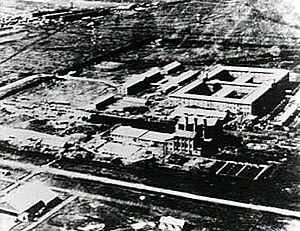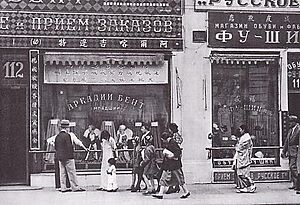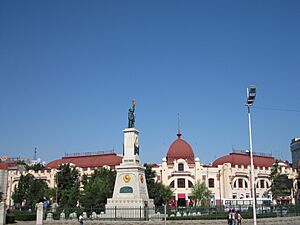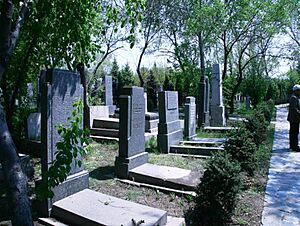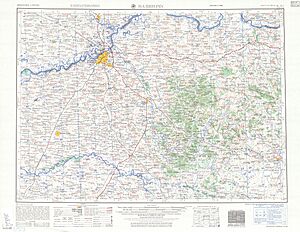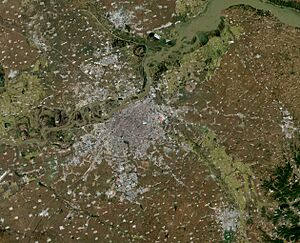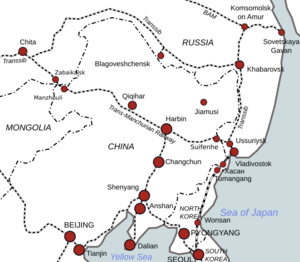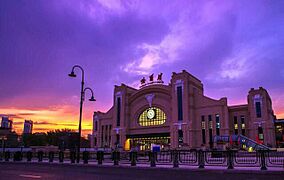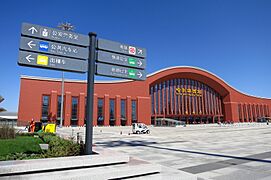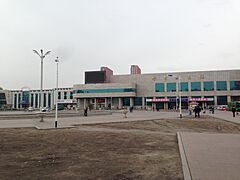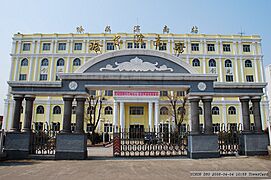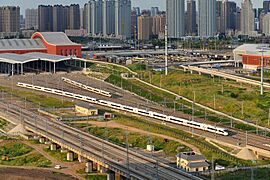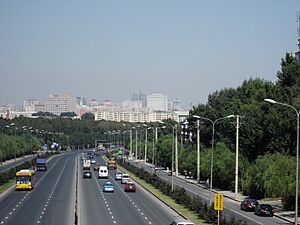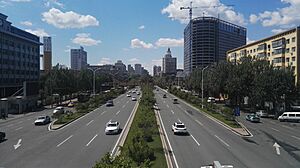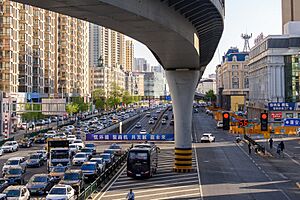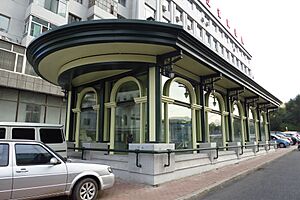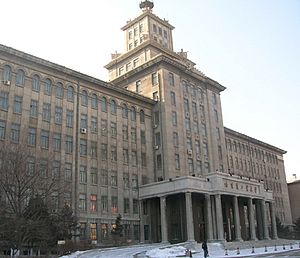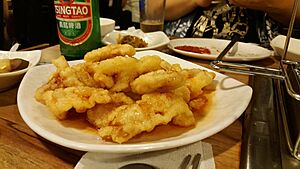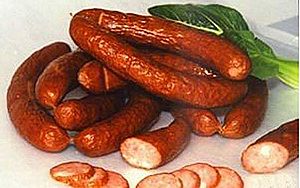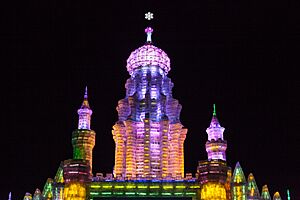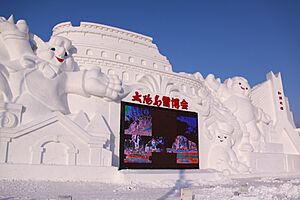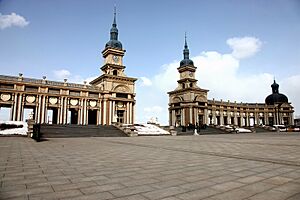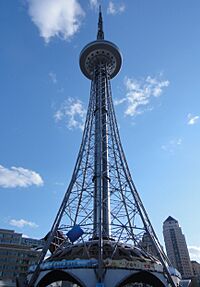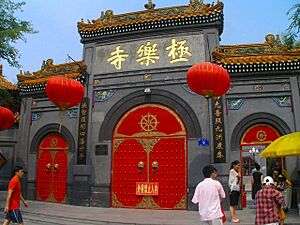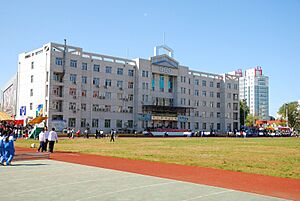Harbin facts for kids
Quick facts for kids
Harbin
哈尔滨市
Ha'erbin, Haerhpin
|
|
|---|---|
|
Prefecture-level and sub-provincial city
|
|
|
Central Street
Sun Island
Nan'gang District
Dragon Tower
|
|
| Nicknames:
Ice City, Oriental Paris, Oriental Moscow, The pearl on the swan's neck
|
|
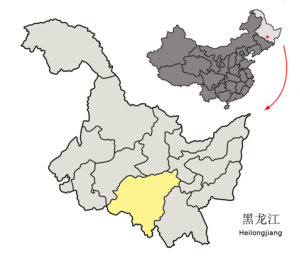
Location of Harbin City (yellow) in Heilongjiang (light grey)
|
|
| Country | China |
| Province | Heilongjiang |
| County-level divisions | 18 divisions, including 9 urban districts, 2 County-level cities, and 7 counties |
| Settled | before 1115 |
| Incorporated - Town |
1898 |
| - County | 1905-10-31 |
| - Municipality | 1921-02-05 |
| Municipal seat | Songbei District |
| Government | |
| • Type | Sub-provincial city |
| • Body | Harbin Municipal People's Congress |
| Area | |
| • City | 53,068 km2 (20,490 sq mi) |
| • Urban | 2,454.5 km2 (947.7 sq mi) |
| • Metro | 10,204.8 km2 (3,940.1 sq mi) |
| Elevation | 150 m (488 ft) |
| Population
(2020 census)
|
|
| • City | 10,009,854 |
| • Density | 188.6232/km2 (488.532/sq mi) |
| • Urban | 6,976,136 |
| • Urban density | 2,842.18/km2 (7,361.22/sq mi) |
| • Metro | 5,841,929 |
| • Metro density | 572.4687/km2 (1,482.687/sq mi) |
| Demonym(s) | Harbinite, Harbinese |
| GDP | |
| • City | CN¥ 575.1 billion US$ 92.3 billion |
| • Per capita | CN¥ 59,027 US$ 9,477 |
| Time zone | UTC+08:00 (China Standard) |
| Postal code |
150000
|
| Area code(s) | 451 |
| ISO 3166 code | CN-HL-01 |
| License plate prefixes | 黑A, 黑L |
| Climate | Dwa |
| City flowers | Lilac |
| Harbin | |||||||||||||||||||
|---|---|---|---|---|---|---|---|---|---|---|---|---|---|---|---|---|---|---|---|

"Harbin" in Simplified Chinese (top), Traditional Chinese (middle), and Manchu (bottom) characters
|
|||||||||||||||||||
| Chinese name | |||||||||||||||||||
| Simplified Chinese | 哈尔滨 | ||||||||||||||||||
| Traditional Chinese | 哈爾濱 | ||||||||||||||||||
| Hanyu Pinyin | Hā'ěrbīn | ||||||||||||||||||
| Literal meaning | (Manchu) "Place of drying fishnets" or (Jurchen language) "Swan" | ||||||||||||||||||
|
|||||||||||||||||||
| Manchu name | |||||||||||||||||||
| Manchu script | ᡥᠠᡵᠪᡳᠨ | ||||||||||||||||||
| Romanization | Harbin | ||||||||||||||||||
Harbin is a major city in Northeast China and the capital of Heilongjiang province. It is known as the "Ice City" because of its very cold winters. Harbin is also called "Oriental Paris" or "Oriental Moscow" due to its unique mix of Chinese and European styles.
The city started as a small fishing village on the Songhua River. It grew quickly after the Chinese Eastern Railway was built by Russians in 1898. Harbin became a hub for trade and culture, especially with Russia. Today, it is an important center for politics, economy, science, and culture in Northeast China.
Contents
Harbin's History
Early Beginnings
People have lived in the Harbin area since at least 2200 BC. The Jin Dynasty was founded here in 1115 AD. Its first capital, Shangjing, was in what is now Acheng District of Harbin. This capital was designed like major Chinese cities.
Later, the Jin capital moved, and Shangjing was abandoned. The Harbin region remained mostly rural until the late 1800s.
An International City Develops
In 1898, a small village began to grow into the modern city of Harbin. This happened because the Russian Empire built the Chinese Eastern Railway. Harbin became the main base for managing this railway. Many Russian engineers and workers came to live here.
Harbin quickly became a busy city. People from all over the Russian Empire moved here, including Ukrainians, Poles, and Jews. The city had a very European look with beautiful buildings and parks. It became a major point for shipping food and goods from Manchuria.
During the Russo-Japanese War (1904–05), Russia used Harbin as a military base. After Russia's defeat, many people from 33 different countries moved to Harbin. Sixteen countries opened consulates there. Harbin became an important international city and an economic center for northeastern China.
A serious health crisis, the pneumonic plague, spread to Harbin in 1910. It killed many residents. Dr. Wu Lien-teh helped stop the plague by suggesting cremation for victims. This was a big step for public health in China.
By 1917, Harbin's population was over 100,000, with many ethnic Russians. After the Russian Revolution in 1917, many Russians who opposed the new Soviet government came to Harbin. The city became a large center for Russian people living outside of Russia. They kept their culture alive with Russian schools, newspapers, and theaters.
The Harbin Institute of Technology was started in 1920 to train railway engineers. It became one of the best engineering universities in the world.
Japanese Occupation Period
In 1931, Japan invaded Manchuria. Harbin was captured by Japanese forces. During this time, Harbin became a base for a Japanese unit called Unit 731. This unit conducted research related to preventing epidemics and purifying water.
Many Chinese revolutionaries fought against the Japanese in Harbin. The Northeast Anti-Japanese United Army was formed to resist the occupation.
Life was hard for Russians in Harbin under Japanese rule. Many left the city. Jewish people also faced difficulties and many moved away.
After World War II
The Soviet Army took control of Harbin in August 1945. In April 1946, the city was handed over to the Chinese People's Liberation Army. Harbin became the first large city governed by the communists. Many Russians who had fled communism were sent back to the Soviet Union.
Harbin became an important industrial city in China during the 1950s. Many factories were built with help from the Soviet Union. However, during the Cultural Revolution, many foreign and Christian influences were removed. Some major factories and universities were moved out of Harbin for safety reasons.
Since 1979, Harbin's economy has grown a lot. The city hosts the China Harbin International Economic and Trade Fair every year. This fair helps connect businesses from over 80 countries.
Harbin once had a large Jewish community. In 2004, Ehud Olmert, a former Prime Minister of Israel, visited his grandfather's grave in Harbin.
Harbin hosted the 1996 Asian Winter Games and the 2009 Winter Universiade. A memorial hall for Ahn Jung-geun, a Korean independence activist, was opened at Harbin Railway Station in 2014.
Harbin's Geography and Climate
Harbin is located in the southern part of Heilongjiang province. It sits on the edge of the Songnen Plain. The city center is on the southern bank of the Songhua River. Harbin is called "The pearl on the swan's neck" because Heilongjiang province looks like a swan.
The city's land is mostly flat and low, about 150 meters above sea level. The eastern parts have mountains and wetlands.
Harbin's Weather
Harbin has a humid continental climate. This means it has very cold, dry winters and warm, rainy summers. Winters are freezing, with average temperatures around -17.3°C in January. The city gets little snow in winter but is often sunny.
Summers can be hot, with an average temperature of 23.7°C in July. Most of the year's rain falls in July and August. Harbin gets about 2,340 hours of sunshine each year. The average yearly temperature is 5.2°C.
City Divisions
Harbin is divided into 9 urban districts, 2 county-level cities, and 7 counties. These areas help manage the large city and its surrounding regions.
Harbin's Economy
Harbin has the biggest economy in Heilongjiang province. In 2015, its total economic output was about 575.12 billion Chinese Yuan.
The rich soil in Harbin is great for farming. This makes Harbin a key area for growing grains and other crops in China.
Harbin also has many different industries. These include light industry, textiles, medicine, food, aircraft, and electronics. Power manufacturing is a major industry. Harbin Electric Company Limited is a big company that makes power equipment. Harbin Pharmaceutical Group is one of China's largest drug makers.
The Harbin International Trade and Economic Fair is held every year. It attracts many businesses and visitors from around the world. This fair helps boost trade and investment in the city.
Harbin is also home to large banks like Longjiang Bank and Harbin Bank. These banks are important for the financial sector in Northeast China.
Transportation in Harbin
Railways
Harbin is a major railway hub in Northeast China. Several train lines connect Harbin to other big cities like Beijing, Shanghai, and Dalian.
In 2012, China opened its first high-speed rail line designed for extremely cold winters. This line connects Harbin to Dalian. Other high-speed lines to Qiqihar, Jiamusi, and Mudanjiang also opened in recent years.
The city has several main railway stations. These include the Harbin Railway Station, Harbin East Railway Station, and Harbin West Railway Station. The Harbin North Railway Station opened in 2015.
- Harbin railway system
Roads
Harbin has a good highway system. Major highways like the Beijing–Harbin Expressway pass through the city. These roads connect Harbin to other important cities and regions.
Air Travel
Harbin Taiping International Airport is about 35 kilometers from the city center. It is the second largest international airport in Northeast China. The airport has flights to many major cities in China and other countries like Russia, Singapore, and South Korea.
A new T2 Terminal was finished in 2017 to handle more flights. Harbin is also planning a T3 terminal shaped like a snowflake, celebrating its "Ice City" nickname.
Metro System
Construction of the Harbin Metro began in 2006. The first line, Line 1, opened in September 2013. It runs from the Harbin East Railway Station to the 2nd Affiliated Hospital of Harbin Medical University. Much of this line uses old air defense tunnels.
Lines 2 and 3 are also being built. Line 3's first phase opened in January 2017. The city plans to build nine metro lines and a circle line by 2025.
Waterways
Harbin has many rivers, including the Songhua River. This makes water transportation easy. Harbin harbor is the largest inland port in Northeast China. Passenger ships sail from Harbin along the Songhua River to other cities and even to Khabarovsk in Russia.
Education and Research
Harbin is a top city for scientific research. It is also a popular place for international students.
The city has several important universities. Many of these focus on science and technology, especially for military and aerospace industries. Some key universities include:
- Harbin Institute of Technology
- Harbin Engineering University
- Harbin Medical University
- Northeast Agricultural University
- Harbin University of Science and Technology
- Harbin Normal University
- Northeast Forestry University
- Heilongjiang University
Harbin Institute of Technology is known as one of the best engineering universities in the world. It has been ranked very highly for its engineering programs. Students and faculty from this institute have created important inventions, like China's first analog computer.
Harbin's Culture
Harbin's culture is a mix of Chinese, Manchu, and Russian influences. This blend can be seen in the city's buildings, food, music, and traditions. In 2010, Harbin was named a UNESCO City of Music.
Delicious Harbin Cuisine
Harbin is famous for its food. The local dishes often combine European and Northern Chinese styles. They use rich sauces and deep-frying.
One very popular dish is Guo Bao Rou. This is a sweet and sour pork dish. It was created in Harbin in the early 1900s. It has crispy fried pork pieces coated in a sweet and sour sauce with honey and ginger.
Other famous local dishes include Demoli Stewed Live Fish, Stewed Chicken with Mushrooms, and Braised Pork with Vermicelli.
Because of its Russian history, Harbin also has many Russian-style foods. You can find Russian restaurants, especially on Zhongyang Street.
A special local food is Harbin-style smoked savory red sausage. It tastes like mild European sausages. This sausage became popular after a Russian merchant started making it in 1909.
Another popular item is Dalieba, a large, round sourdough bread. It came from Russia and has been sold in Harbin for over a hundred years. It has a unique sour and chewy taste.
Kvass, a fermented drink made from bread, is also popular. And don't forget Madier ice cream on Zhongyang Street! It's a little salty but sweet and creamy.
Tourism and Winter Fun
Harbin is a popular place for tourists, especially in winter. The city is famous for its amazing ice sculpture displays. There's also a huge indoor ski park at Wanda Harbin Mall. In the 2023–2024 winter, Harbin had 87 million visitors!
Harbin's European-style buildings are also a big draw. Places like the Saint Sophia Cathedral, Central Street, and the old Baroque buildings in Lao Daowai are beautiful to see.
Harbin is nicknamed "Ice City" because of its very cold winters. From December to March, the city is decorated with ice and snow sculptures.
The annual Harbin International Ice and Snow Sculpture Festival has been held since 1985. There are two main areas for viewing: huge snow sculptures at Sun Island and the "Ice and Snow World." At Ice and Snow World, you can see illuminated buildings made from thick blocks of ice taken from the Songhua River. It takes thousands of workers to create these amazing sculptures.
Winter activities include skiing, snowmobiling, winter swimming in the Songhua River, and the traditional ice-lantern exhibition in Zhaolin Garden. This festival is one of the four largest ice and snow festivals in the world.
Harbin: The Music City
Harbin has a rich musical history. The Harbin Symphony Orchestra, founded in 1908, is China's oldest. The Harbin No.1 Music School, started in 1928, was the first music school in China. Many famous musicians have studied there.
Every summer, the "Harbin Summer Music Concert" is held. It's a national festival with artists from all over the world. In 2006, a concert with 1,001 pianos set a new Guinness World Record!
Media in Harbin
Harbin has its own television and radio stations. Heilongjiang Television (HLJTV) broadcasts on several channels. Harbin Television (HRBTV) is the city's local station. There are also radio stations like Long Guang and Harbin People's Broadcasting Station.
Harbin's Architecture
Harbin is famous for its unique blend of Chinese and European building styles. Many old Russian and European buildings are protected. This mix gives Harbin its nicknames "Oriental Moscow" and "Oriental Paris."
Historical Buildings
Central Street is a main shopping area. It shows off many European architectural styles like Baroque and Byzantine. You can see Russian bakeries and French fashion houses there.
The Saint Sophia Cathedral is a beautiful Russian Orthodox church. It was built in 1907 and expanded until 1932. Today, it is a museum that tells the story of Harbin. The church is a great example of Byzantine architecture.
The Ji Le Temple, a Chinese Buddhist monastery, was built in 1921. Many Russian Orthodox churches were destroyed or abandoned over time. Today, about 10 churches remain.
Sports in Harbin
Harbin is a center for winter sports in China. It has hosted major events like the 1996 Winter Asian Games, the 2009 Winter Universiade, and the 2025 Asian Winter Games. Many famous winter sports athletes come from Harbin. These include Olympic medalists in speed skating and figure skating.
Harbin has an indoor speed skating arena, the Heilongjiang Indoor Rink. It is the oldest of its kind in China.
The city is also a growing hub for bandy, a sport similar to ice hockey. The China national bandy team is based in Harbin.
Heilongjiang Lava Spring F.C. is a professional soccer team from Harbin. They play their home games at the Harbin International Conference Exhibition and Sports Center.
An indoor ski resort opened in Harbin in 2017. It is one of the largest in the world, allowing people to ski all year round.
International Connections
Harbin has partnerships with about 30 cities around the world. In 2009, Harbin opened an International Sister Cities museum. This museum shows exhibits from its partner cities.
In 2015, China and Russia agreed to reopen the Russian consulate in Harbin. This helps strengthen ties between the two countries.
Famous People from Harbin
Many notable people come from Harbin, including:
- Han Cong (born 1992), a Chinese pair skater.
- Simu Liu (born 1989), a Chinese-Canadian actor.
- Ningning (born 2002), a Chinese singer in the K-pop group Aespa.
- Song Jia (born 1980), a Chinese actress and singer.
- Sui Wenjing (born 1995), a Chinese pair skater.
More to Explore
- Chinese Baroque Street
- Harbin Ferris Wheel
- Harbin Siberian Tiger Park
See also
 In Spanish: Harbin para niños
In Spanish: Harbin para niños


